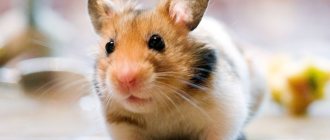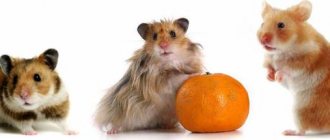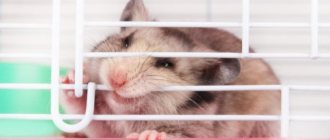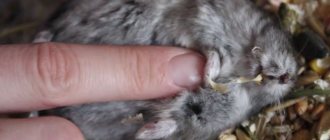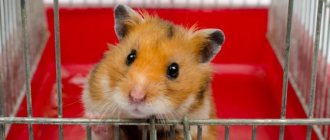/ Hamsters / The main differences between the Djungarian hamster and the Syrian
0
3026
Article rating
One of the most popular pets in our apartments are hamsters. Caring for little fluffies does not require much effort, but they bring joy and tenderness to their owners, both adults and children. There are two common breeds of these rodents in our country. What are the differences between the Djungarian hamster and the Syrian?
Differences between the Djungarian hamster and the Syrian
Djungarian hamster. Appearance
This is a very miniature animal with a pointed muzzle and small ears. Its body weighs no more than 50 grams with a total length of no more than 10 cm. As a rule, it is covered with thick short fur, which in natural conditions is usually gray-brown in color with white patches. A blackish or dark gray stripe is expressed along the line of the spine - this is a common species characteristic for dzungarians. The belly, paws and inside of the animal's ears are usually white or light. The eyes are bulging and black.
The domestic Djungarian hamster differs in color from the wild one. There is a usual set of colors for domesticated animals: this is standard (gray-brown body with a white belly), sapphire color (bluish-gray, also with a light belly), pearl (whitish with gray splashes) and tangerine (cream with a red tint).
But you need to take into account that individuals of this species molt in winter and become almost white - because of this, and also because of their small size, the dzhungarika is sometimes called the Russian winter dwarf hamster. Nature has provided for the hamster to be invisible in the snow, because dwarfs do not hibernate and in winter conditions must also take care of food. However, it should be noted that in captivity, molting with color change rarely occurs.
Who is who?
It is immediately worth noting that representatives of the breeds in question not only have external differences, they also have different habits and character.
We will compare the breeds in tabular form for ease of study and comparison of parameters.
| Djungarian hamster | Syrian hamster |
| The size of the individual is no more than 10 cm. | The body length of the Syrian representative can reach even 20 cm. |
| A characteristic wide dark stripe is visible on the back, and a diamond is clearly visible on the head. | The color is most often golden, but there are other varieties of coat color. There are no stripes on the body. |
| They are very active, always trying to run away or hide somewhere. | They have a more phlegmatic character compared to the Djungarians. |
| Sociable dogs, having become accustomed to their owner, make good contact with him. | They are very sociable, love to sit in arms and receive affection from people. |
| They need sufficient space, as they are too active and mobile. | Due to its large size, the rodent needs more space. |
| Not particularly suitable for children, as the baby is too fragile and nimble. | Perfect even for children, it will bring a lot of joy. |
| It is not always possible to train your pet to use the litter tray. Djungarians are neat, but they are extremely difficult to train. | They are clean and well accustomed to the tray. |
| The most ordinary cage for rodents with a fine mesh is suitable for keeping. | A larger cage will be needed. |
| The animal is prone to developing diseases such as diabetes. It is necessary to exclude some sweet fruits from the diet. | They are omnivores, but despite this it is better to offer a complete diet. |
| Males emit a stronger odor than females. | Once every 1-3 days during estrus, females can emit a smell. |
| They have short fur. | There are different types, both with short and long fur. |
| The scent glands are located on the tummy. | Scent glands are located on barrels |
You can also see the external differences between these breeds in the photo.
Where does it live in nature?
Many people are interested in where and how the Djungarian (or Sungur) hamster lives in wild natural conditions. This interest is not just caused by curiosity: after all, in order to provide the best living conditions for an animal in captivity, it is important to know what the lifestyle of its wild ancestors was like.
In the Russian expanses, this type of hamster is very common, for example, in Khakassia, in some regions of Kazakhstan, and in the steppes of Southwestern Siberia. For its habitat, this rodent, due to its food preferences, chooses semi-deserts and steppe spaces where cereal herbaceous plants grow.
Djungarian hamsters are most active at night. They live in minks, which necessarily have several entrances and holes, as well as a nesting chamber.
The life expectancy of this rodent in the wild is short - no more than two, sometimes three years. At home, it usually increases, but only slightly.
Differences between Syrian and Djungarian hamsters
Representatives of both breeds are cute, fluffy and easy to keep animals. But there are significant differences between them that everyone who is going to a pet store should become familiar with. In fact, it is quite simple to distinguish a Djungarian from a Syrian: you just have to look at the appearance of the rodents. But the differences lie not only in appearance, but also in character. The secrets of keeping and characteristics of your future pet are discussed later in the article.
Did you know? Hamsters can be called animals with many children: a female can bring up to 20 babies at a time.
Size
Even an amateur cannot make a mistake when given the task of distinguishing a Djungarian hamster from its Syrian counterpart based on this criterion. The fact is that dzhungariks are real crumbs. Their length, if you count the small, barely noticeable tail, is a maximum of 10 cm, and such a fluffy animal weighs no more than 50 g. The Syrian hamster, in comparison with its small relative, is a real giant, since it is at least twice as large. Its “large” body reaches a length of as much as 20 cm and a weight of 150–200 g.
Color
Even if you decide to have hamsters of both breeds in your house, you will never be able to confuse them, because they will be contrastingly different in color. Thus, miniature Djungarians are covered with short, smooth and shiny fur, which has a gray-brown color, often with red and golden tints. The main distinguishing feature is the expressive dark stripe along the back. These little ones can rightfully be called chameleons: with the onset of winter, their fur coat lightens, almost to a white shade, and the dorsal stripe becomes barely noticeable.
Syrians are, first of all, goldens, as they are distinguished by reddish (even bright copper) or peach colors with many shades. Although you can often find black hamsters of this breed, and silver-gray ones with blue tints, and even white ones with red eyes.
Important! Thanks to the efforts of breeders, you can buy both short-haired and long-haired Syrian hamsters, which are reminiscent of the Angora rabbit in their fluffiness.
Lifespan
Among the differences between these two breeds of small domestic rodents, it is worth noting their life expectancy. Djungarian hamsters live an average of 2 years, with a maximum of 2.5. If we talk about Syrians, their age can reach 3.5 years. What unites these completely different hamsters is that if they are properly cared for, their lives can be extended. It is very important to identify and diagnose the disease in your pet in time and organize the correct treatment, since the diseases (often tumors) from which these animals suffer can lead to their premature death. If your pet becomes inactive, begins to itch and worry, and also squeaks, bites you, becomes aggressive, and his eyes are watery, then you should immediately contact a veterinarian.
Behavior
The personalities of both breeds of hamsters are also radically different. Dzungarians are distinguished by their independence and love of freedom. Even if this rodent lived with you from a very early age, you will not be able to tame it: it will not climb into your arms, and you will not be able to pet it - the animal will get angry and bite. But, at the same time, Djungarians are quite friendly animals: they can be placed in a cage of two or even more at once (but you need to choose same-sex individuals). Representatives of this breed are highly trainable.
Compared to their cousins, Syrian hamsters love to be touched and petted. They behave well and restrainedly, are calmer, will often crawl around their owner, sleep on his lap, almost never show aggression, and are distinguished by affection and contact.
Did you know? It is worth remembering that the Syrian hamster is a recluse: he will not share his cage with another hamster.
Content Features
Although many owners do not listen to this opinion, Djungarians should not be placed several times in one cage. However, as evidenced by the experience of keeping this species in captivity, it is best if there is only one animal in one cage.
Keeping a male and female together will result in offspring. If the animals are not further planted, their numbers will grow exponentially, and instinct will force the adults to eat their young. Usually this immediately causes understandable rejection among the owners, but here it should be understood that hamsters in their natural environment do not live in families, but in single individuals in each area, and captivity conditions cannot change this. Therefore, if a female hamster has offspring, they should be placed separately upon reaching a certain age (as soon as young hamsters are able to feed on their own).
It is also not recommended to keep two same-sex hamsters together: in this case, aggression towards each other is possible, both in females and males. In addition, living together in the same cage can cause stress in each of the inhabitants, and this will inevitably affect their owners as soon as they try to communicate with them.
It is best to feed Djungarian hamsters in captivity with special food.
It is worth noting that pet stores quite often sell animals of hybrid origin under the guise of a Djungarian hamster. Such individuals may have an unstable psyche and a tendency to various diseases, including diabetes. A conscientious breeder will always provide you with a pedigree upon request.
Now let’s look at materials about another, no less popular human companion animal.
Determining the sex of small hamsters
These signs are best visible already in two-month-old individuals, but in general, obvious characteristics are visible after 4 weeks. It is impossible to determine the gender of a newborn baby.
If you look closely at the butt of small hamsters, you will notice two small round spots, raised at the edges, of a pink hue. This is the anus and urinary opening.
By the gap between you can determine the gender of the baby. In females they are located very close, sometimes it may seem that there is only one hole, but this is not the case at all. In boys, the anal passage is located directly under the tail, and the hole for urine removal is on the abdomen closer to the center. In the genital area you can find a round “swelling” - this is the development of the testes.
The most common mistake is the desire to see if the animal has testicles. Thanks to this approach, the owner often makes the wrong conclusion, since Djungarian hamsters have quite small genitals. In babies, they have not yet fully formed, and sometimes even in a sexually mature male, the testes do not descend into the scrotum, but are hidden in the abdominal cavity.
If the testicles can be easily seen, then there can be no mistake in determining the sex of the Djungarian hamster - this is a boy. An almond-shaped rounded formation in the pet’s genital area can be noticed 6 weeks after the birth of the rodent. With age, the testes become larger, and gender can be determined without difficulty.
Syrian hamster. Description
This representative of the Khomyakov family is larger than the Djungarian - together with the tail (1.5 cm), the body length of this rodent is 13 (in rare cases, up to 18) centimeters. In this case, the weight can reach 120-125 grams. Representatives of this species, also called Golden hamsters, are distinguished, respectively, by the golden or brownish color of their thick, soft fur. In the process of domestication and selection, the variability of coat color has expanded significantly: Syrian hamsters can be, in addition to the main colors, black and silver-white, as well as bicolor and even tortoiseshell.
A feature that is assigned to all hamsters in animal science, but is especially noticeable among Syrians, is the presence of cheek pouches. They are designed to transport food that the animal obtains while exploring the surroundings to its burrow. In addition, if there is a lot of food, this hamster also tends to store it in its bags. When full, the sacs sag from the cheeks to the very shoulders of the animal, which is why the name of this hamster is translated from Arabic as “Mr. Saddlebags.”
The remaining features that can be distinguished when comparing the Syrian hamster and the Djungarian hamster are the former’s prominent protruding ears, a slightly more elongated muzzle, and the absence of a dark dorsal stripe.
Which hamster is suitable for a child?
Hamsters are very popular pets. Children are especially sensitive to furballs and often ask their parents to get a hamster. The animal is unpretentious, inexpensive and takes up little space in the house.
Which hamster is best for a child? Syrians are good-natured creatures. Dzungarians are wayward. Under unfavorable conditions they become mischievous and bite. But remember that the character of hamsters of the same breed is different.
Both breeds can be kept at home. But any pet needs to be properly cared for. Before getting a pet, a child must clearly understand that they need to be responsible for it.
The size of the cage depends on the size of the animal. Miniature hamsters should choose a house with closely spaced rods. Otherwise, the animals may escape. When the opportunity arises, active dwarfs will run away from the cage.
The difference between breeds is also in life expectancy. Syrian hamsters live about 2.5 years. Dzungariks are a year longer. Housing conditions affect the lifespan of animals. If you take good care of your pet and prevent the development of diseases and tumors, it will live longer.
Possible symptoms of animal illness:
- Restlessness and itching.
- Passivity and apathy.
- Discharge of mucus from the nose and watery eyes.
- Display of aggression when trying to pick up an animal.
- The presence of a tumor in a specific area of the body.
Examine your pet for the following symptoms to maintain health and prolong its life. If necessary, contact a specialist. Wooden branches, mineral or chalk stone help maintain healthy teeth.
In the wild, animals live together mainly during mating. To breed pets, place them in one house for several days during the mating season. After a certain period, expect offspring.
It is better for babies to live with their mother for the first days of life. After 2-4 months, the animals begin to conflict. Disagreements can lead to injury and death of animals. Make sure you can keep your animals separate from each other. Do not crossbreed representatives of different breeds.
Coat types
Through the work of breeders, four separate subspecies of Syrian hamsters have been bred. These subspecies are distinguished by the following types of coat. The most common and common is the short-haired type. With such plush-like fur, different colors look best.
Long-haired Syrians have also been bred, another name for which is Angora. Males of this subspecies have a kind of “skirt” of long (8 to 10 cm) hair in the lower part of their body. However, the females look like ordinary Syrians, perhaps a little fluffier. In foreign pet stores, this variety is called “Teddy Bear hamster”.
The Satin or Satin Syrian hamster is distinguished by fur with a special, almost glossy sheen. This effect was achieved by breeding a new variety whose fur contained hollow hairs. However, individuals of Satin Syrians cannot be mated with each other, since this may result in the birth of animals with sparse hair or its complete absence.
Rex (or Curly) hamsters give the impression of being disheveled animals - the hairs in their lush outfit are slightly curled. In addition, rexes also have curled mustaches. This variety can be either short(-) or long-haired.
The last variety is represented by Hairless Syrian hamsters. They are characterized by a complete absence of hair. However, animals with such a fixed mutation sometimes still have a certain velvety appearance and even short “whiskers”.
Unfortunately, representatives of hairless Syrians are quite sickly, they require special care: in unfavorable temperature conditions, some owners even “dress” them. In addition, the life expectancy of a hairless Syrian hamster is half that of normal.
Where does it live and what does it eat?
Unlike the Djungarian hamster, the range of this animal is quite limited: it is found in Syrian, Turkish and Israeli semi-deserts. Due to human activities and the species' status as a pest, the Syrian hamster's habitat is in constant decline, and the species is now listed as endangered according to the International Union for Conservation of Nature (IUCN).
Like other hamsters, this one is most active at dusk or dawn. The Syrian is quite mobile: observations by zoologists have shown that during the “night shift” this animal is capable of running from three to eight kilometers. When clarifying which is better - the Djungarian or Syrian hamster - keep in mind that the Syrian is more active, and often this activity manifests itself in the evening, when he begins to run around on the wheel and explore his home in every possible way.
The life expectancy of the Syrian hamster is short, it is the same as that of the Djungarian hamster. This circumstance greatly upsets those who want to have this pet, who are thinking about which is better - a Syrian or a Djungarian hamster.
The diet of the Syrian is much wider: this animal is considered a practically omnivorous rodent, because it is able to feed not only on cereal seeds and all types of nuts (which, by the way, are prohibited for Djungarian hamsters), but also on small insects. Of the nuts, however, almonds and fruit seeds are contraindicated for Syrians.
How to choose
Before buying a hamster, people are puzzled, which pet should they get? In general, hamsters do not differ much in care and maintenance. The choice of a particular animal, fur length, color, size and other external characteristics depend on personal preferences.
Which one is better to buy for a child?
An animal is not a toy, but a great responsibility. Of course, caring for a pet develops responsibility, observation and in every possible way stimulates the child to communicate with the animal.
However, it is worth considering that keeping a hamster in a family with a small toddler can have a detrimental effect on the fate of the pet. If parents have not explained to the child in an accessible form about the fragility of the body, then the child, without calculating his strength, may cause pain.
The hamster will not keep you waiting and will repay you with a very painful bite. The friendliness of the pet or the type of breed is not important here; the reaction of any rodent will be the same.
For a child who knows what is good and what is bad, taking care of a pet will be an excellent activity for overall development. An affectionate and attentive attitude will bring mutual pleasure.
If your child has allergic reactions to six, you should not have a pet.
Which is better: Dzungarian or Syrian
The charm of a Syrian or the charm of a Dzungarian? Despite the fact that all hamsters are charming animals, there are clear differences among the breeds in the color, habits, size and training of the pet.
The Syrian hamster occupies a leading place in the world in popularity and is rightfully considered a friendly breed towards the owner and his family.
Perhaps the largest rodent, capable of growing up to 250 grams. The hamster can be either long-haired or short-haired. The color of the fur coat comes in all shades of gold, but a predominance of dark colors is also acceptable - black, brown or gray.
Syrians are real long-livers, life expectancy reaches 4 years. Smart, easily trained animals, willing to make contact. Active and inquisitive. To develop muscles, additional accessories, walks around the apartment and sand for bathing are required. If poorly cared for, the fur coat emits an unpleasant odor.
If the owner’s plans do not include breeding offspring, then the Syrian hamster should be kept alone, due to its jealous attitude towards its home.
Djungarians get along well with children.
The Djungarian hamster is an adorable fluffy pet. Common as a pet and loved for its sociability, gentle nature and activity. Clean, grows up to 10 cm, weight 35-65 grams. Depending on the ambient temperature, the color of the fur coat changes; in warm weather it is gray, and with the onset of cold weather it turns white. It is distinguished by its particular agility; when trying to escape, it develops a decent speed, which makes it difficult to catch.
Curious, often exhibits exploratory talent and is easy to train. The animal is prone to obesity and the development of diabetes; a more carefully thought out diet is required.
Interesting facts about hamsters.
Boy or girl: who is better?
A calm male or an affectionate female? When choosing between genders, there is not much difference between animals. If the owner is not faced with the question of breeding the breed, then the differences between the male and female consist of a slight discrepancy:
- Female hamsters are energetic and capable of being active during the daytime. They can demonstrate aggression, especially towards offspring. They are clean, they take care of their home as diligently as they care for the condition of their coat. They do not tolerate interference on their personal territory. They love to cuddle up to their owner.
- Males are calmer, but more odorous. In addition to the ability to mark territory, they secrete secretions from the endocrine system. They exceed females in size, and their possession develops fighting qualities.
Content
Like the Djungarian hamster, the Syrian is considered a territorially intolerant animal: the cubs should be separated from their mother as soon as they are four weeks old. Once the young animals reach eight weeks of age, in order to avoid conflicts, they should not be kept with each other either.
Remaining in the burrow, these hamsters behave like active housewives, sorting and sorting through food supplies, separating those that have spoiled.
In order for the hamster to move more, it is worth installing a special wheel in the cage. Well, all types of hamsters need wooden blocks or pieces of mineral stones to grind down their teeth.
What you need to know about hamsters?
For keeping in an apartment, Syrian and Djungarian hamsters are absolutely identical. It is believed that Djungarian boys and girls love more space. Do these pets stink? What to do if you have a tumor? Is it possible to train hamsters and what is the best name for a pet? More on this later in the article.
Diseases
Despite the fact that rodents are considered hardy creatures, it still happens that they are overtaken by various diseases, including cancerous tumors. There may also be food poisoning. Why? The fact is that food supplies often spoil and cause a reaction when eaten. Treatment in this case can be done at home. But if your pet does not feel better within a day, then it will be necessary to carry out treatment in the presence of a veterinarian.
It happens that the fluffy stuffs his paw. Then a swelling, bruise or even a fracture may occur. If your baby squeaks, bites, or, conversely, lies lifelessly on his back, do not speculate about why this happened, but rather consult a doctor immediately to begin treatment as soon as possible!
The average lifespan of hamsters is from two to three years (with good care and the absence of cancer, pets, especially dzhungariki, can live up to four years). But if the rodent is not well looked after and treated for various diseases in a timely manner, then it may die earlier. For example, if your hamster itches or looks sick, it is best to take him to the clinic as soon as possible.
Most often, the symptoms of diseases (including tumors) look like this:
- The hamster is itching and looks restless.
- He is not as active as before.
- The pet's eyes itch, water, and mucus comes out of the nose.
- It squeaks and bites if you bring it close to your hands.
- A tumor appears on an area of the body, which can become a source of pain for the rodent.
Even one of these symptoms may indicate the need for treatment for the disease!

